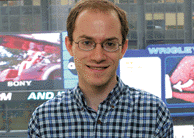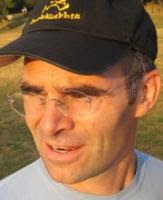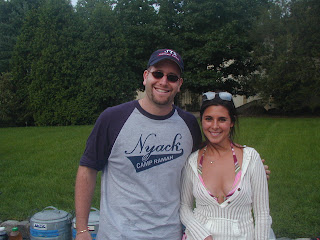I am hesitant to write anything about the recent press that indie minyans has gotten because as kol raash gadol recently wrote on Jewschool for their Picks for Best of 2007: “Blinding Flash of the Obvious Finally Reaching the Mainstream Radar Years After Everybody Else Got the Memo: Indie minyanim.”
But since the New York Times recently wrote about the subject (“Challenging Tradition, Young Jews Worship on Their Terms”) and the online journal Zeek dedicated an entire issue to indie minyans, I thought I would weigh in.
The success of independent minyans really shouldn’t be news because their success was inevitable. Indie minyans are an obvious recipe for success:
1) Gather a bunch of young, single professional Jews in a large metropolitan area (New York City, Chicago, LA, DC, or Boston).
2) Mix in some young Jewish grad students along with some young married Jewish couples.
3) Send out an e-mail about an “informal gathering” (read: spirited prayer service that won’t remind you of your grandfather’s shul) to take place in someone’s apartment on Friday before dinner or Saturday morning around 10 AM.
3.5) Allow the e-mail to go viral and with some word-of-mouth dozens of young Jewish men and women will flock to the get-together.
4) After several months of these get-togethers, select a larger location to rent and this will turn into another start-up independent Shabbat prayer group.
 This is basically how the popular Kehilat Hadar traces its roots. I realized what an independent minyan was while sitting in Rabbi Ethan Tucker and Ariela Migdal’s Manhattan apartment (a few floors above our own apartment at the time) on a Shabbat morning in April 2001. I was invited to the minyan and asked to schlepp four of my folding chairs up eight flights of stairs. Little did I know at the time that the three minyan founders, including Tucker and his Harvard buddy Elie Kaunfer (right), were on to something. With sixty young Jews packed into an Upper West Side apartment davening (praying) like they were at Camp Ramah, a new type of synagogue community was forming.
This is basically how the popular Kehilat Hadar traces its roots. I realized what an independent minyan was while sitting in Rabbi Ethan Tucker and Ariela Migdal’s Manhattan apartment (a few floors above our own apartment at the time) on a Shabbat morning in April 2001. I was invited to the minyan and asked to schlepp four of my folding chairs up eight flights of stairs. Little did I know at the time that the three minyan founders, including Tucker and his Harvard buddy Elie Kaunfer (right), were on to something. With sixty young Jews packed into an Upper West Side apartment davening (praying) like they were at Camp Ramah, a new type of synagogue community was forming.
The next gathering was held in a larger apartment — the home of my JTS rabbinical school classmate Dr. Len Sharzer. Len was the oldest student in my class but was not the oldest individual at the minyan that morning. That distinction was held by the late Marcia Lieberman, mother of Senator Joe Lieberman. Joe and Hadassah Lieberman were in town for the graduation of their daughter-in-law (Ethan Tucker’s wife Ariela Migdal) and attended the minyan that morning. I was honored to have the aliyah right after the distinguished senator from Connecticut.
From there the Hadar Minyan grew and grew with almost 200 in attendance for a Tisha B’Av service in Central Park. Hadar Minyan became Kehilat Hadar, and when Elie Kaunfer was ordained as a rabbi he created Mechon Hadar which has given birth to Yeshivat Hadar and the Minyan Project. The Yeshiva is a a full-time, community open to men and women looking to engage in intensive Torah study, prayer and social action. The Minyan Project promotes education, consulting and networking for independent prayer communities.
At the 2004 UJC General Assembly held in Cleveland, I attended a session in which Elie Kaunfer was one of the panelists. His response to what Gen X’ers were looking for in a spiritual community was fresh and innovative, yet also full of unknowns for the future. The indie minyans were gaining in popularity, but still no one could speculate what would happen when the indie minyannaires needed a true spiritual leader in their lives — a rabbi. A chavurah-like environment seems fine when you’re single or newly married, but when your oldest kid is celebrating her bat mitzvah it is helpful to have a rabbi. As the indie minyannaires get older my guess is that they will join established congregations that employ salaried clergy. However, they will greatly influence the way these synagogues and temples carry out their mission. Simply stated, they won’t settle for the way things have always been done in their grandfather’s shul.
In addition to how the members of indie minyans will come to change established congregations in the near future, another question is how rabbis may come to be welcomed into the indie minyans in some form of leadership role. This issue was taken up on a Jewschool post by Yehudit Bracha in September 2006: What IS the role of the rabbi in the independent minyan movement?
 A great example of a dynamic rabbi in an emergent congregation is Rabbi Andy Bachman (left), the founder Brooklyn Jews and once executive director of Reboot. Andy is now the rabbi of Beth Elohim in Brooklyn (a Reform congregation in Park Slope). He recently posted an especially thought-provoking blog post about creating a transparent pulpit. My classmate, Rabbi Rachel Nussbaum, also became the rabbi of an emergent spiritual community when she founded Kavanah in Seattle a few years ago. And the dynamic Rabbi Sharon Brous has been wildly successful with Ikar-LA, the emergent spiritual community she created in 2004.
A great example of a dynamic rabbi in an emergent congregation is Rabbi Andy Bachman (left), the founder Brooklyn Jews and once executive director of Reboot. Andy is now the rabbi of Beth Elohim in Brooklyn (a Reform congregation in Park Slope). He recently posted an especially thought-provoking blog post about creating a transparent pulpit. My classmate, Rabbi Rachel Nussbaum, also became the rabbi of an emergent spiritual community when she founded Kavanah in Seattle a few years ago. And the dynamic Rabbi Sharon Brous has been wildly successful with Ikar-LA, the emergent spiritual community she created in 2004.
These rabbis are serving their congregations in new and innovative ways. They are leading their communities with much different leadership styles than rabbis who led in generations past. Because of their leadership, their congregations function differently and their congregants come to view synagogue life much differently. These emergent spiritual communities have Facebook pages, blogs, and only communicate to the membership via e-mail. These rabbis will answer a congregant’s question with SMS on their Blackberry. They even buy their Torah scrolls on eBay. These are the shuls of the future.
I must give my colleague Rabbi Elie Kaunfer a lot of credit. It would have been quite the accomplishment had he only co-created Hadar, however, he has taken it many steps further by forcing us to consider how independent minyanim will change the future of community building, communal prayer, rabbinic leadership, affiliation, and synagogue structure. Working with Synagogue 3000, he surveyed individuals about the role of “emergent spiritual communities” in the future of Judaism.
The introduction to the survey states:
Over the past few years, we have seen an important new phenomenon in Jewish life: the creation of dozens of independent minyanim, spiritual communities, alternative worship services, and emergent congregations. This rich array adds diverse opportunities for worship, learning, social justice work, community-building and spiritual expression.
We knew very little about the thousands of people associated with these new endeavors. Who are they? What are their concerns? How do they feel about the communities they’re creating, joining, and building? Why do they participate?
To answer these questions, the S3K Synagogue Studies Institute, in collaboration with Mechon Hadar, conducted a survey designed by the prominent sociologist Steven M. Cohen in partnership with Rabbi Elie Kaunfer and Shawn Landres. Our goal was to find out more about the participants, members, partners, and “acquaintances” of these new spiritual communities. The results of this work is the first ever portrait of the interests, values, and concerns of a critical innovative turn in American Judaism.
The report about the new movement of independent minyanim, “EMERGENT JEWISH COMMUNITIES and their Participants”, was published this past Fall and should be required reading for every rabbi and future rabbi, synagogue and temple board members, and anyone interested in the future of Judaism. In fact, anyone with a vested interest in organized religion should study this report.
Bottom line? Independent Minyans are necessary. They are serving a purpose for a whole generation of spiritually undernourished Jews. They are quickly changing how Jewish spiritual communities operate and serve their members. However, just as online banking and ATM’s are wonderful, they have not replaced traditional banking institutions or the humans who work there. The chavurah movement of the 1970’s did not replace rabbis and neither will the independent minyan movement at the beginning of the 21st Century. Rabbis will always be needed in Jewish life, we will just have to adapt our roles to modern times.
Links about Independent Minyans:





